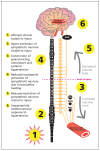Emergency management of autonomic dysreflexia with neurologic complications
- PMID: 27221275
- PMCID: PMC5056874
- DOI: 10.1503/cmaj.151311
Emergency management of autonomic dysreflexia with neurologic complications
Figures


References
-
- Phillips AA, Krassioukov AV. Contemporary cardiovascular concerns after spinal cord injury: mechanisms, maladaptations and management. J Neurotrauma 2015;32:1927–42. - PubMed
-
- Hinchey J, Chaves C, Appignani B, et al. A reversible posterior leukoencephalopathy syndrome. N Engl J Med 1996;334:494–500. - PubMed
-
- Consortium for Spinal Cord Medicine. Acute management of autonomic dysreflexia: individuals with spinal cord injury presenting to health-care facilities. J Spinal Cord Med 2002;25 Suppl 1:S67–88. - PubMed
Publication types
MeSH terms
Substances
LinkOut - more resources
Full Text Sources
Other Literature Sources
Medical
